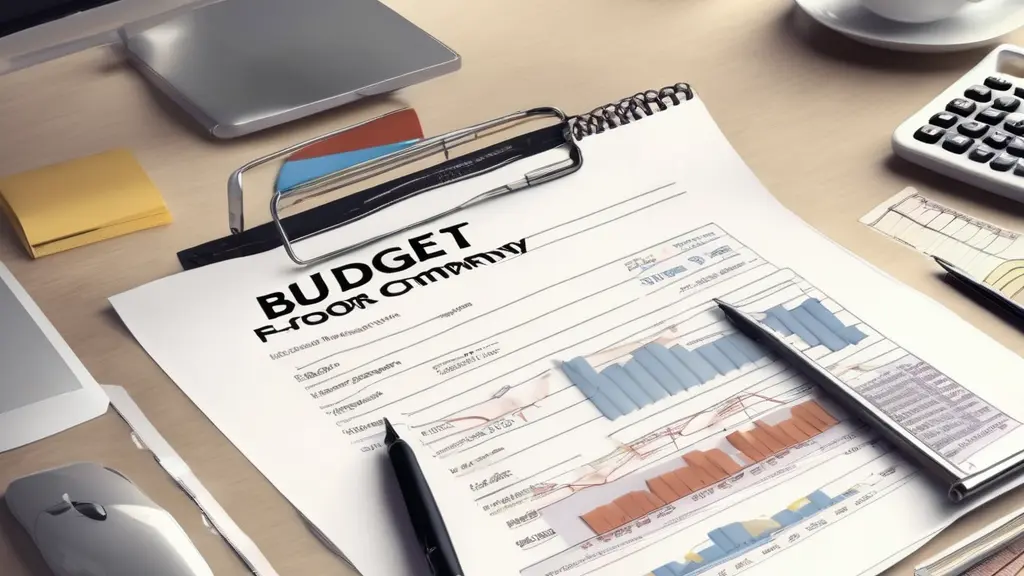How to prepare budget for a company? Creating a well-planned budget is crucial for any business to manage its financial resources effectively. It involves forecasting revenue, estimating expenses, and allocating funds accordingly.
A budget helps control costs, identify financial shortfalls, and make informed decisions. To prepare one, gather financial data, categorize expenses and project sales, and align spending with strategic goals.

In this article, we will explore the critical steps in crafting a comprehensive budget, including revenue projections, expense tracking, variance analysis, and budget review processes, enabling you to maintain financial stability and achieve your business objectives.
How to Prepare Budget for a Company?
To prepare a budget for a company, follow these key steps:
- To understand historical trends, gather financial data from previous years, such as income statements, balance sheets, and cash flow statements.
- Set specific, measurable financial goals aligned with the company’s overall vision and priorities.
- Categorize all business expenses into areas like payroll, rent, marketing, utilities, etc.
- Forecast expected revenue and sales based on past performance, new initiatives, and market factors.
- Allocate resources and funding across operational needs and growth opportunities that support your goals.
- Monitor actual income/expenses versus budgeted numbers regularly and make adjustments as needed.
- Gain leadership approval for the comprehensive budget plan, then implement and communicate it company-wide.
Gather Necessary Information
Before we start crunching numbers, we need to gather some essential information. It’s like gathering ingredients for a delicious financial soufflé (yes, I just compared budgeting to cooking – bear with me).
First, you’ll need to collect your company’s past financial records, including income statements, balance sheets, and cash flow statements from previous years.
These documents will help you gain a solid understanding of your company’s financial history and identify trends and patterns.
Next, assemble your team of financial wizards. This might include your accounting department, department heads, and any other key stakeholders who can provide valuable insights into their respective areas.
Understanding Your Financial History
Now, let’s examine those financial records. Imagine them as a treasure trove of valuable information waiting to be unearthed and analyzed.
Answering these questions will give you a solid understanding of your company’s financial patterns, strengths, and weaknesses. It’s like studying the battle scars of a seasoned warrior before embarking on a new campaign.
Set Financial Goals and Objectives
With your financial history in hand, it’s time to set some goals and objectives for the upcoming year (or whatever period you’re budgeting for). Think of these as the shining beacons that will guide your budgeting decisions.
Examples of Financial Goals:
- Increase revenue by 15%
- Reduce operational expenses by 10%
- Launch a new product line
- Expand into a new market
- Improve cash flow management
Make sure your goals are SMART (Specific, Measurable, Achievable, Relevant, and Time-bound). That way, you’ll have a clear target to aim for and can quickly evaluate your progress along the way.
Aligning Goals with Your Company’s Vision
Your financial goals should be more than just numbers on a spreadsheet. They should be intrinsically linked to your company’s overall vision and strategic objectives.
By aligning your financial goals with your company’s big-picture vision, you’ll ensure that your budgeting efforts are driving your business in the right direction.
Categorize Expenses

Now comes the part where we roll up our sleeves and dive into the nitty-gritty details of your expenses. Think of this as the “spring cleaning” phase of budgeting, where we sort through every nook and cranny of your company’s spending habits.
Start by creating a comprehensive list of all your expenses, from the big-ticket items like rent and payroll to the most minor office supply purchases. Then, organize these expenses into categories for better visibility and analysis.
Common Expense Categories:
| Category | Examples |
|---|---|
| Payroll & Benefits | Salaries, bonuses, health insurance, retirement contributions |
| Rent & Utilities | Office rent, electricity, water, internet |
| Marketing & Advertising | Digital ads, print materials, events, promotions |
| Office Expenses | Supplies, equipment, software subscriptions |
| Professional Services | Legal fees, accounting services, consulting |
| Travel & Entertainment | Business trips, client meetings, team outings |
The Art of Cost-Cutting
As you categorize your expenses, keep an eye out for areas where you can potentially cut costs without compromising your company’s operations or growth plans.
Remember, the goal here is not to slash expenses indiscriminately but to identify opportunities for intelligent cost optimization. It’s a delicate balance between fiscal responsibility and maintaining a healthy, productive work environment.
Forecast Revenue and Sales
Now that we’ve tackled the expense side of the equation, it’s time to turn our attention to the revenue forecast. After all, a budget without projected income is like a ship without a sail – it’s not going anywhere fast.
Start by analyzing your company’s past sales data and identify any trends or patterns. Are there certain products or services that consistently generate the most revenue?
Are there seasonal fluctuations in your sales? Understanding these nuances will help you make more accurate revenue projections.
Next, consider any new products, services, or initiatives that you plan to launch in the upcoming budgeting period. Consult with your sales and marketing teams to get their input on potential revenue streams and growth projections.
The Art of Realistic Forecasting
While it’s tempting to be overly optimistic with your revenue forecasts (who doesn’t love a little positive thinking?), it’s crucial to strike a balance between ambition and realism.
Remember, an unrealistic revenue forecast can throw your entire budget out of whack and lead to disastrous consequences down the line. It’s better to err on the side of caution and adjust your projections as needed throughout the year.
Allocate Resources
With your expenses and revenue forecasts in hand, it’s time to allocate your precious resources according to your company’s goals and priorities.
Start by identifying your core operational expenses – the bare necessities that keep your business running smoothly.
These might include payroll, rent, utilities, and essential software or equipment. As these expenses are non-negotiable, allocate funds to cover them first.
Next, prioritize the initiatives and projects that directly support your financial goals and strategic objectives.
For example, if one of your goals is to increase revenue by 15%, you’ll want to allocate resources toward marketing, sales, and product development efforts.
The Art of Balancing Priorities
Allocating resources is a delicate balancing act between short-term needs and long-term investments.
It’s easy to get caught up in the immediate demands of day-to-day operations, but neglecting future growth opportunities can be detrimental to your company’s success.
Finding the right balance is critical. You don’t want to spread your resources too thin, but you also don’t want to be so laser-focused on the present that you miss out on future opportunities.
Monitor and Adjust
Congratulations! You’ve created a comprehensive budget that aligns with your company’s goals and priorities. But don’t pop the champagne just yet – the real work is just beginning.
Budgeting is an ongoing process that requires constant monitoring and adjustment. Think of it as a living, breathing organism that needs to be nurtured and cared for throughout the year.
Regularly review your actual expenses and revenue against your budgeted figures. Look for any significant variances or
The Art of Agile Budgeting
Monitoring and adjusting your budget is all about being agile and responsive to changing circumstances. The business world is ever-evolving, and your budget needs to evolve with it.
Don’t be afraid to make adjustments to your budget as needed. Rigidly sticking to an outdated plan can be just as detrimental as having no plan at all.
Embrace the art of agile budgeting, and your company will be better equipped to navigate the twists and turns of the business landscape.
Seek Approval and Implementation
With your budget carefully crafted and fine-tuned, it’s time to seek approval from the powers that be (a.k.a. your company’s leadership and stakeholders).
Prepare a clear and concise presentation that outlines your budgeting process, assumptions, and rationale behind your decisions.
Use visuals, charts, and graphs to help tell your financial story in a compelling and easy-to-understand way.
The Art of Persuasion
Seeking approval for your budget isn’t just about presenting numbers – it’s about persuading your audience that your plan is sound, well-researched, and aligned with the company’s best interests.
Tips for a Successful Pitch:
- Highlight how your budget supports the company’s overarching goals and objectives.
- Demonstrate the due diligence and research that went into your projections and assumptions.
- Address potential concerns or objections transparently and proactively.
- Be prepared to defend your decisions and provide data-driven justifications.
Remember, your budget is more than just a collection of numbers – it’s a strategic roadmap that will guide your company’s financial decisions for the foreseeable future. Treat it with the gravity and importance it deserves.
Once your budget has been approved, it’s time to put it into action. Communicate the details to all relevant stakeholders, implement any necessary changes or processes, and establish clear accountability and reporting mechanisms.
Conclusion
Congratulations, fellow budgeting warrior! You’ve navigated the treacherous terrain of expense categorization, revenue forecasting, and resource allocation. Your battle-hardened budget now stands ready to lead your company to financial victory.
But remember, budgeting is an ongoing odyssey, not a one-time conquest. Embrace the art of agile budgeting, staying vigilant and responsive to changing circumstances.
Regularly monitor your progress, make adjustments as needed, and never stop seeking opportunities for optimization and growth.
With a solid budget as your trusty compass, your company will be well-equipped to chart its course through calm seas and stormy waters alike.
So raise a glass (or a spreadsheet, whichever floats your boat) to the power of strategic financial planning – the cornerstone of any successful business endeavor.
Happy budgeting, my friends! May your balance sheets be ever in the black and your profits soar to new heights.






1 thought on “The Art of Budgeting: how to prepare budget for a company?”